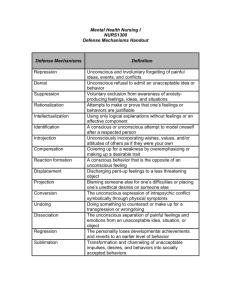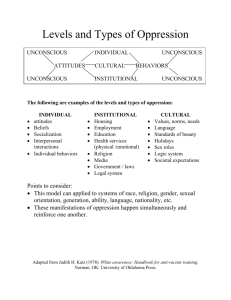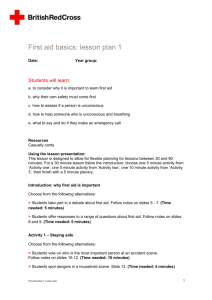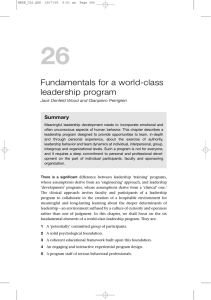11 Learning for leadership: The ‘engineering’ and ‘clinical’ approaches
advertisement
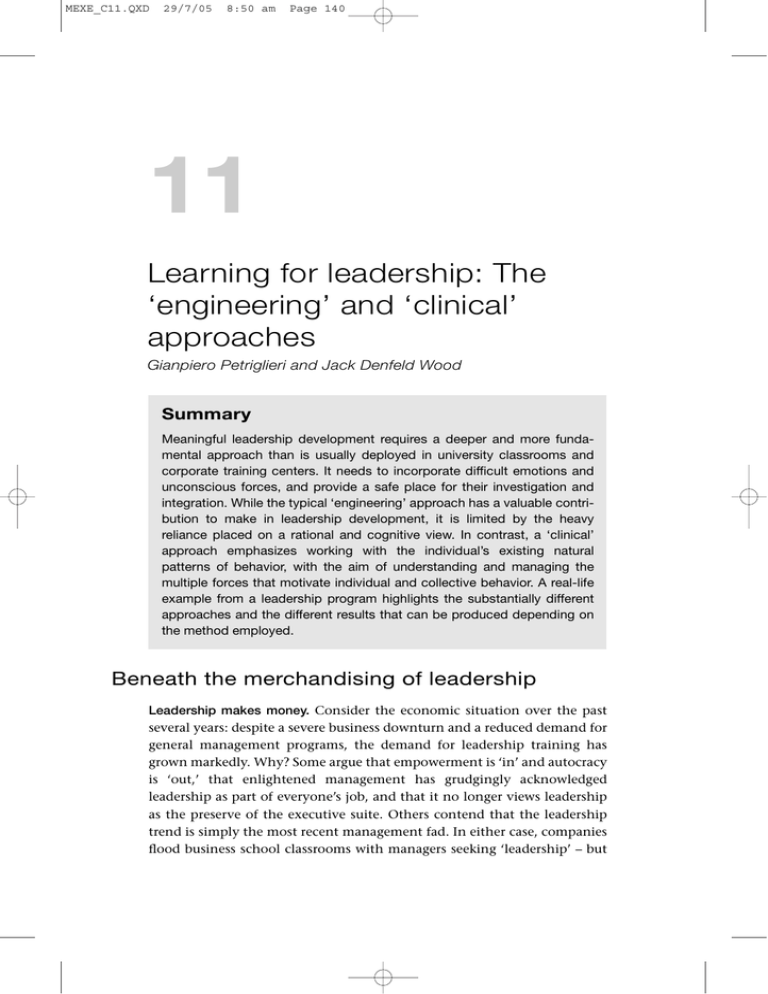
MEXE_C11.QXD 29/7/05 8:50 am Page 140 11 Learning for leadership: The ‘engineering’ and ‘clinical’ approaches Gianpiero Petriglieri and Jack Denfeld Wood Summary Meaningful leadership development requires a deeper and more fundamental approach than is usually deployed in university classrooms and corporate training centers. It needs to incorporate difficult emotions and unconscious forces, and provide a safe place for their investigation and integration. While the typical ‘engineering’ approach has a valuable contribution to make in leadership development, it is limited by the heavy reliance placed on a rational and cognitive view. In contrast, a ‘clinical’ approach emphasizes working with the individual’s existing natural patterns of behavior, with the aim of understanding and managing the multiple forces that motivate individual and collective behavior. A real-life example from a leadership program highlights the substantially different approaches and the different results that can be produced depending on the method employed. Beneath the merchandising of leadership Leadership makes money. Consider the economic situation over the past several years: despite a severe business downturn and a reduced demand for general management programs, the demand for leadership training has grown markedly. Why? Some argue that empowerment is ‘in’ and autocracy is ‘out,’ that enlightened management has grudgingly acknowledged leadership as part of everyone’s job, and that it no longer views leadership as the preserve of the executive suite. Others contend that the leadership trend is simply the most recent management fad. In either case, companies flood business school classrooms with managers seeking ‘leadership’ – but MEXE_C11.QXD 29/7/05 8:50 am Page 141 11 ■ Learning for leadership what is it that they are really looking for? Overtly, the purpose of leadership training is the acquisition of tools and techniques to facilitate corporate goals. Covertly, the appeal of leadership training appears to be coming from somewhere else. The dismantling of formal corporate structures and the disappearance of job stability has left today’s manager with an acute sense of anxiety and insecurity.1 Traditional hierarchies, stable organizations and life-long employment, however unfashionable and inefficient for the pace of modern business, used to satisfy the human need for structure2 and provided a sense of security. The psychological function of much organizational structure, as scholars at the British Tavistock Institute have pointed out, is to provide social defenses against unavoidable feelings of anxiety.3 The ‘contract’ was clear: individuals joining an organization relinquished some of their freedom in exchange for protection. No longer. When we ask executives what they want from a leadership program – what they are really looking for – the answer is unequivocal: tools to influence and manipulate others in order to regain some degree of control, over their direct reports, their bosses, their organizations, their careers and their lives.4 Looking for leader Every group, no matter how large, needs leadership. And hope for a better future. Ambitious leaders owe their ascension less to their desire for power and visibility than to their ability to capitalize on the followers’ needs for reassurance, and to create a vaguely plausible plan of action rather than one that reflects an objective appraisal of the situation at hand.5 Social scientists and depth psychologists have long known that anxiety and uncertainty drive groups to select leaders who provide a simple and reassuring picture of reality, and within that ‘reality,’ a simple vision of a goal and the means for achieving it. To remain in power, leaders and followers collude in denying the ‘chaotic complexity in which so much of human life is lived.’6 They insulate themselves from the dissonance of discordant views, in the process concealing or suppressing alternative perceptions of reality. Reality, however, has a habit of imposing itself on even the most creative collective fictions. Few leaders, especially in difficult historical moments, can build a fiction solid enough to last, and so they inevitably are found inadequate. When the gap between the shared fiction and the complexity of the real world becomes too wide, leaders fall from grace. At that point, their followers 141 MEXE_C11.QXD 142 29/7/05 8:50 am Page 142 Developing learning materials and methodologies seldom engage in serious collective soul-searching about what went wrong, and instead take the simple way out – adopting a new leader who offers an alternative fiction. The ‘rise and fall of leaders’ follows an archetypal template that repeats itself, from dependency and deification to disillusionment, demonization and, finally, replacement. With few exceptions, things only change on the surface. If we temporarily lose our fascination with great leaders, we can never abandon our deep-seated need for the shared fictions that help us deal with the complexity and distress of contemporary life. Today, the idea of ‘leadership’ has replaced the search for ‘great leaders’ and ‘great corporations’ that are no longer viewed as dependable or as offering sufficient protection against the anxiety of modern economic life.7 Managers feel increasingly vulnerable and seek ‘leadership skills’ as a new means of protection. In other words, they are looking for hope – on the ‘leadership market.’ And there’s no shortage of dealers in hope. Recently, the sales vice-president of a privately held conglomerate that distributes a wildly successful weight-loss product in the US put it this way: When I train sales-people, I say to them, “Do you know what people are calling you for? It isn’t the pill. They are calling you for hope. That is really what they want from you.”8 The company that produces the pill has no offices and no labs. The conglomerate’s marketing team created its name because it sounded scientific.9 It’s not about testing chemicals, nor even about selling products that work – it’s about marketing hope. From a psychological standpoint, the leadership industry also markets hope. It caters to the human tendency to invest in gifted individuals and seek magical solutions that offer the illusion that we can control our anxieties and our destiny. This tendency is the driver of the leadership industry’s main ‘product lines’ – the glorification of celebrity chief executives, the merchandising of ‘Great Leader’ books and the teaching of leadership ‘models’ and ‘toolkits.’10 Merchandising leadership includes mass-market ‘autobiographies,’ one-minute cookbooks, leadership fables, inspirational lectures, and ‘fun and games’ outdoor exercises of various sorts.11 These products are seductive – and remarkably simplistic. If managers seek to protect themselves against emotional uncertainty, corporations, in turn, try to manage their employees’ turmoil by outsourcing the responsibility for emotional support to executive ‘coaches’ MEXE_C11.QXD 29/7/05 8:50 am Page 143 11 ■ Learning for leadership and leadership programs. Once a kind of surrogate mother, organizations now hire business schools to function as surrogate nannies. Today’s business schools tackle the market demand for ‘leadership programs’ – to help manage the pressing emotional demands of their participants – with one of two approaches: engineering or clinical. In the engineering case, leadership faculty deploy an array of tools and techniques to fortify executives’ defenses, so that their anxiety and emotional stress can be held at bay and their company’s primary task can be accomplished. In the clinical case, leadership faculty provide a space where emotions can be explored and integrated, so that anxious energy can be transformed into energy for individual learning and personal and professional development. Both approaches are useful, but they are based on radically different psychological assumptions about human development (see Table 11.1 for summary). The engineering approach to leadership training According to Edgar Schein’s pioneering work on corporate cultures, the basic assumptions of the ‘engineering culture’ are the following: engineers are proactively optimistic and assume that they can and should master nature. They are stimulated by puzzles and problems. They are pragmatic perfectionists who prefer ‘people free’ solutions; their ideal world is one of elegant machines and processes working in perfect precision and harmony without human intervention. ‘Engineers’ are concerned with safety, and over-design for it; and they prefer linear, quantitative thinking with simple cause-and-effect solutions.12 While the majority of management professors might not have engineering degrees, their approach to research and teaching leadership works from the same set of assumptions: 1 What makes us tick The engineering approach to leadership training rests heavily on a rational and cognitive view. Leadership, in this view, is a collection of individual attributes or a set of skills; it is modern and changes with culture, century and civilization. Support for the engineering approach stems from the assumptions embedded in basic economics and cognitive psychology: people tend to behave in ways they associate with rewards, and avoid behaving in ways they associate with punishments. For example, if research indicated that certain behaviors would enhance their career advancement 143 MEXE_C11.QXD 144 29/7/05 8:50 am Page 144 Developing learning materials and methodologies prospects, managers would naturally be motivated to learn and apply those behaviors to get ahead. 2 Learning to lead Within this framework, leadership skills can be identified and learned through practice and emulation. The engineering approach describes a set of desirable leadership behaviors and provides the related theories, models and tools to ‘train’ participants through study, imitation, practice and feedback. For the individual, the effort to change and improve needs to be sustained by a conscious resolution to keep applying oneself and improving. 3 The value of self-reflection The engineering approach encourages self-reflection for diagnostic purposes – to compare and contrast oneself with desired (or ‘correct’) behaviors and with others. Self-reflection clarifies individual beliefs and values, increases awareness of one’s dominant leadership ‘style,’ assesses one’s key strengths and weaknesses, focuses on desired areas for change, and identifies potential internal and external obstacles to that change. After this initial ‘gapanalysis,’ self-reflection becomes just a part of the review and feedback process as executives practice and gain proficiency in applying the necessary leadership ‘tools.’ Executives are encouraged to reflect before and after they act, both to respond to their present context appropriately and to spot potential areas for further improvement. 4 The use of theory Engineering-minded management faculty value theories more to solve practical problems than as explanations of reality. For them, theory tends to be ‘normative’ and ‘prescriptive’ – the former in the sense that ‘this is the way things are’ and the latter as in ‘this is what you should do about it.’ For example, the recognition that storytelling and ‘mythic themes’ inspire people more than spreadsheets and bar charts led a popular screenwriter to dispense advice on how to construct management stories with a mythological flavor.13 Similarly, a finding that many ‘accomplished leaders’ suffered a major failure early in their career prompted some academics to suggest that young and arrogant executives with promising career prospects ought to be denied a promotion, in order to humble them and pre-empt some ‘future failure’ – an application of a ‘fail now, succeed later’ strategy.14 MEXE_C11.QXD 29/7/05 8:50 am Page 145 11 ■ Learning for leadership 5 Learning methods Leadership faculty make every effort to maximize the impact of their courses – they have to be entertaining, inspirational and motivating. A central space is given to motivational speeches of former athletes and retired CEOs, breathtaking views on mountaintop walks, the thrill of helicopter rides, camps in the wilderness, and similar amenities. Role-playing and experiential activities provide a means to measure relative ‘success’ and practice ‘new ways of behaving.’ The emphasis is on the emulation of others. Smoothly enacted planned behavioral routines and the attempt to keep distressing feelings hidden and under control is viewed as a clear sign of progress. The quicker one appears to change, the better. 6 Faculty attitude The engineering approach underpins the overwhelming majority of leadership programs. The underlying issue, of course, is control. Ideally, there is a tool for every problem, and the more tools one masters, the more control one should attain. The more control one believes one has, the more reassured both professor and participant should feel. 7 Managers’ reactions Most managers exposed to this type of leadership training first experience great enthusiasm, only to lapse into disappointment later. Once back home, they sometimes feel worse than they did before – if nothing has fundamentally changed despite their expensive training, they think something must be wrong with them. Nothing is. In our view, the reason for this moodreversal is the same as the reason for the programs’ initial popularity. The ‘engineering’ approach promises to rid participants and faculty of discomfort. Convincingly, but only for a moment, it tries to leave the unconscious and emotional factors behind. The engineering approach will always be needed and it will always have a central place in management education. Executives cannot hope to exercise leadership effectively without a grasp of their organization’s primary task, and a solid base of knowledge and skill, both technical and strategic. When thoughtfully done, the engineering approach works brilliantly to enhance technical skills, even very complex ones, such as flying fighter aircraft, performing surgery or playing a good game of golf. These endeavors require dedicated study, strong focus, constant practice, good feedback and 145 MEXE_C11.QXD 146 29/7/05 8:50 am Page 146 Developing learning materials and methodologies frequent performance review. Leadership, however, is not quite like a perfect golf swing. The clinical approach to leadership development By employing the word ‘clinical,’ we are not invoking emotionless doctors in white coats scribbling on clipboards – quite the opposite. The focus of the clinical approach is our humanity in all its emotional complexity. While the engineering approach focuses on assessment and judgment as a means for improvement, and provides strategies, techniques and tools to cope with, and control, behavior, the clinical approach focuses on exploring and deepening our working knowledge of natural human behavior so as to permit more autonomous, better informed, decisions.15 Working with a clinical approach means using both accumulated knowledge and present experience to understand what’s really going on, at a given moment, in the social system in which we find ourselves – or that we are trying to change. It involves addressing situations facing us without excessive reliance on prescribed procedure and technique, working collaboratively with colleagues and clients, and considering the influence of elusive, emotional and unconscious aspects of human behavior. 1 What makes us tick Individuals and groups are not simply manipulated by rewards and punishments presented by others in an overt social context. Covert unconscious forces play a central role in motivating individual and collective behavior. Leadership in this view is an interaction of psychological ‘energy’ that includes both domains – conscious and unconscious – within any social system. Learning to recognize, understand and work with these unconscious influences is the only way to avoid being inadvertently surprised, disturbed or unwittingly controlled by them. 2 Learning to lead Leadership is a universal human phenomenon, and its essence has not changed over millennia. The leadership training of the engineering approach is not the same as leadership development of the clinical one. Within a clinical framework, managers are not complex machines in need of fixing and upgrading – they are human beings naturally seeking growth and integration. Training is about acquiring and practicing something new. MEXE_C11.QXD 29/7/05 8:50 am Page 147 11 ■ Learning for leadership Development is about exploring and dealing with things that we already have with us – growth works ‘from the inside out.’ The integration of one’s ‘thinking’ and ‘feeling,’ for example, is an invaluable instrument for leading responsibly. Leadership can’t be taught, but the capacity to lead can be learned and developed – less from academic study and imitation than from the experience of leading and following. Meaningful behavioral learning occurs only as a result of a strongly felt need and a personal decision. It is impossible to coerce somebody into leading. It would be equally impossible to develop leadership if executives were not truly allowed to be curious, experiment, and make mistakes – i.e. if they were prevented from taking the lead in their own development. 3 The value of self-reflection The clinical approach encourages the manager to reflect as they act, to develop what we call reflective spontaneity – the capacity to be oneself and use one’s experience as data while engaged in action. To do so, this approach provides a space where one can explore and experiment in a relatively safe environment. One can learn, for example, that difficult feelings might not be as harmful as we often believe – on the contrary, they provide us with invaluable information. We measure success by the capacity to let ourselves experience, and then make sense of, an increasingly full range of emotions, behaviors and reactions. 4 Use of theories The clinical approach is more ‘pragmatic’ and ‘descriptive’ than it is normative and prescriptive. Rather than state ‘this is what you should do,’ it suggests that ‘this is how to understand what is happening, and here are some choices about what to do.’ It uses whatever theory in a given case might provide a reasonable framework for understanding the meaning of people’s actions, so that one can choose how to act – or whether to act at all. 5 Learning methods The clinical approach does not rely on inspiring stories or the emulation of celebrity executives for reassurance and comfort. Rather than practicing ‘new behaviors’ and acquiring control tools, executives are encouraged to be themselves, experience what is happening, and reflect upon the complex and conflicting emotions that they usually avoid. Role plays and 147 MEXE_C11.QXD 148 29/7/05 8:50 am Page 148 Developing learning materials and methodologies experiential activities are not used to demonstrate proficiency in imitating ‘how to do it right’ but as data collection opportunities for later reflection on ‘how you do it.’ The more naturally and spontaneously participants behave, the more learning material emerges. However, this is not a prescription for their behavior. Reluctance and defensiveness are as natural and spontaneous as are openness and enthusiasm. As long as one is willing to explore what provokes one’s behavior, one can learn from the program and further one’s leadership development. 6 Faculty attitude The clinical approach strives to bring the unconscious back into play in the corporate classroom, in an effort to enhance the relevance, depth and meaning of leadership education. A central assumption is that the primary responsibility to learn is with the client. Whereas the engineering approach is centered on its models, the clinical approach is centered on its clients, and it does not assume that the faculty knows best what managers should know in order to exercise leadership. Clinically minded management faculty tend to be more curious about what participants will learn within the context provided. Their approach fosters interdependence between participant and faculty, but it is the participants who remain firmly in charge of their learning. 7 Managers’ reactions Unlike those exposed to the engineering approach, who often move from enthusiasm to disappointment, participants in a clinical program usually go through a different sequence – from an initial mixture of anxiety, suspicion and impatience with the faculty for lack of both clear-cut solutions and directive teaching, through a feeling of relief for not having to ‘fake it,’ to a realization that they are already equipped to exercise leadership responsibly and wisely, and already have a sense of how to lead others in ways that increase health and foster growth for all concerned. Which unconscious? Some detractors of the clinical approach reject the concept of the unconscious altogether. Other critics, while not denying the unconscious, argue that working with it might open up ‘a can of worms’ that is best left to the psychotherapist. This discomfort, argues Insead’s psychoanalyst Manfred Kets de Vries, is a defense against the idea that our behavior will always MEXE_C11.QXD 29/7/05 8:50 am Page 149 11 ■ Learning for leadership elude our best intentions – the existence of an active unconscious sweeps away the illusion of being fully in control.16 However, depictions of the unconscious as a hidden puppeteer lend it a somewhat sinister character that keeps us imprisoned in a repetitive loop of childhood behavioral patterns.17 Those either hostile or sympathetic to the reality of the unconscious both tend to pathologize it. We have come to see it differently. Our experience has made us somewhat skeptical of such a gloomy view. We put less emphasis on the unconscious as an obstacle that constantly threatens us than as a source of richness and vitality. The unconscious that animates human life is not just the Freudian container of repressed memories and irrational wishes. To be sure, some psychic wounds are always present when one explores an individual’s psychology, but the unconscious with which we are mostly concerned is the Jungian one of collective images and living archetypes. If we are scuba diving in the images of the unconscious, it is less to uncover emotional shipwrecks and more to explore the natural aquatic flora and fauna hidden from the surface. We assume that the enrichment of individual and collective experience comes from seriously engaging and playing with image and metaphor. Our goal is neither to harness unconscious processes to gain influence and control over the external environment, nor even to reduce immediate distress. Instead, it is to experience and become more familiar with archetypal images and patterns of behavior in an effort to gain a measure of lasting integration with our deeper selves – so that we can lead from our psychological center. Working with feelings Whereas both the engineering and clinical approaches acknowledge the primary importance of emotion in the exercise of leadership, their attitudes towards emotions are radically different. The engineering approach is geared to assess and adjust to a norm; the clinical approach is geared to understanding and developing uniquely individual capabilities. A concrete example can illustrate the differences between the two approaches. Not long ago, during the debriefing of an inter-group competition in an IMD leadership program, one of the participants expressed extreme disappointment and anger at the behavior of the leader of another group, who had publicly dismissed and humiliated him. The participant candidly admitted that he felt mounting aggression towards the leader, 149 MEXE_C11.QXD 150 29/7/05 8:50 am Page 150 Developing learning materials and methodologies which reminded him of how he felt immediately before a fistfight, years before. Working from an engineering approach, one of our colleagues instantly remarked, ‘Aggression is a primitive instinct . . . an animal reaction.’ His air of disapproval was proportionate to his poise and self-righteousness. He then launched into a dual attempt to ‘help’ the upset manager understand how ‘dysfunctional’ his reaction was, and to ‘coach’ him to explore ‘more appropriate’ ways to respond. Shamed and disappointed with himself, the participant nodded and listened dispiritedly to the defensive strategies that he should employ to suppress his aggressive impulses. From an engineering standpoint, the participant had exhibited a personal inadequacy that he needed to overcome through hard work, so that it wouldn’t happen again. In contrast, from a clinical standpoint, a great learning opportunity was slipping by. The participant’s verbal expression of deeply rooted anger was an invitation for an extended exploration of authentic feelings, a chance to learn how to understand and resourcefully manage the complexity of all our reactions to everyday organizational behavior. The clinical response was: ‘Aggression has helped humans survive for millennia, and I doubt we’ll eradicate it from our nature in a couple of weeks. So let’s try to understand why it manifested itself in this particular occasion . . .’ As we de-pathologized aggressive feelings and legitimized their exploration, we were able to examine what happened. Archaic impulses have their own integrity and can be used diagnostically to reveal what is really going on within and between groups. An initial angry reaction is a natural response to being treated unfairly. In this case, its emergence was a strong signal that the interaction between the groups had turned into a confrontation; the anger wasn’t one participant’s personal failure, but rather a clue to managing an unconscious ‘power play’ at work in the larger social system. In the debriefing, the class experimented with how to express feelings, reflect on them, and wonder about their purpose at the same time. Later, another participant applied the same skill in a similarly heated exchange by pausing and asking herself, ‘I am noticing myself getting aggressive. I wonder if this negotiation is becoming a fight. Why would that be?’ – a transaction that neither required suppression of her feelings, nor an attack on another individual, nor placing a fake smile on one’s face. MEXE_C11.QXD 29/7/05 8:50 am Page 151 11 ■ Learning for leadership Conclusion More than ever before, executives turn to schools of business administration for help in dealing with the mounting pressures of contemporary managerial life. The difficulty of modern corporations to satisfy dependency needs, and the failure of publicly acclaimed leaders to hold at bay the discomfort of reality, has led managers to invest their desires for reassurance, direction and structure in the acquisition of ‘leadership skills.’ In the midst of overwhelming uncertainty, they turn to ‘leadership training’ to regain some control and restore hope. The promise of hope abounds in the leadership mass market. However, the selling of ‘leadership as a happy pill’ by educational and consulting organizations is questionable at best and irresponsible at worst. Taken together, the engineering approach’s lure of reassurance, reliance on crude models for emulation, and illusion of control undermine the goal of developing deeper leadership skills. Easy reassurance and superficial morale boosts are counterproductive when it comes to serious personal development and lasting behavioral change. If we are to provide conditions that help executives develop the capacity to lead effectively and responsibly in turbulent times, such simplistic expedients are best avoided. Leadership is a social-psychological phenomenon, and its roots reach deeply into individual and collective psychological terrain. Meaningful leadership development – whether individual or organizational – requires a deeper and more fundamental approach than is usually employed in university classrooms and corporate training centers. It needs to incorporate difficult emotions and unconscious forces, and provide a safe space for their exploration and integration. Uncertainty, discomfort and anxiety can be unpleasant but they are necessary and useful; the effort to control or suppress them, via the engineering approach, is a diversion from genuine development. In order to foster leadership development, the clinical approach creates a safe space to take risks and switches focus from action to reflection, from short-term reassurance to long-term change, from emulation to experimentation, and from self-control to self-discovery. A shift in attitude from avoidance and rationalization to engagement and integration of emotions requires a willingness to accept them, recognize their value, and explore their implications – for the individual, the group and the organization. With a more generous acceptance, ambivalent feelings are useful and reliable aids for leadership development. Welcoming their exploration is not easy. Nor is it meant to be. But it can be immensely rewarding. 151 MEXE_C11.QXD 152 29/7/05 8:50 am Page 152 Developing learning materials and methodologies Key take-aways ■ An ‘engineering’ approach to leadership training relies on teaching individuals tools and techniques for influencing others and controlling individual behavior. ■ The engineering approach gives the illusion of control but is ultimately ineffective in developing deeper leadership skills. ■ A ‘clinical’ approach focuses on leadership development, where emotions and the unconscious aspects of human behavior are explored and integrated. ■ Meaningful leadership development is a process of self-discovery and development and requires elements such as risk taking, reflection, recognition and acceptance of one’s own feelings. ■ Those exposed to a clinical program are more likely to develop authentic and responsible leadership. Table 11.1 An ‘engineering’ versus a ‘clinical’ approach to leadership development Engineering approach Clinical approach Prescriptive – normative use of theories Descriptive – pragmatic use of theories Focuses primarily on visible behavior and external reality Focuses primarily on the interaction between external and internal reality Works well for technical and cognitive skills Works well for behavioral and emotional skills Orientation is on ‘performance’ Orientation is on ‘meaning’ Focus is on adding skills Focus is on making sense of things Primary reliance on training cognitive and rational analytical skills Primary reliance on development and integration of rational and emotional capacities Individuals are motivated by external rewards and punishments Individuals are motivated by instinctual drives and socialized desires Operating metaphor is electromechanical: the individual is like a networked computer Operating metaphor is ecological: the individual is a living organism in a fluid system One ‘upgrades’ by fixing or adding One ‘upgrades’ by exploring and integrating Learning is a teaching process that happens from the ‘outside in’ Learning is a developmental process that happens from the ‘inside out’ MEXE_C11.QXD 29/7/05 8:50 am Page 153 11 ■ Learning for leadership Table 11.1 continued Engineering approach Clinical approach Encourages emulation of role models and smoother enactment of ‘appropriate’ feelings and behaviors Encourages ‘reflective spontaneity’ and familiarity with a range of feelings and behaviors Leaves the unconscious out of the dialogue Includes the unconscious as part of the dialogue Pathologizes ‘bad’ emotions Accepts all emotions as normal Learning is the acquisition and application of objective tools Learning is the recognition and calibration of the ‘self-as-instrument’ Aim is ‘progressive’ and future-oriented Aim is the integration of past, present and future Leadership is a collection of individual attributes or a set of skills Leadership is an interaction of psychological ‘energy’ that occurs within a larger social system Leadership is modern and changes with culture, century and civilization Leadership is a timeless and universal human phenomenon Leadership can be taught and imitated – process is ‘teacher-centric’ Leadership can be learned and developed – process is ‘learner-centric’ Fosters dependent and counterdependent relations with authority Fosters interdependent and independent relations with authority Programs need to demonstrate immediate impact and boost participant morale Programs need to provide opportunity for long-term relevance and lasting personal change Notes 1 Miller, E.J. (1999) Dependency, Alienation, or Partnership? The changing relatedness of the individual to the enterprise. In: French, R. and Vince, R. Group Relations, Management and Organization. Oxford: Oxford University Press, pp. 98–111. 2 Berne, E. (1964) Games People Play. New York: Grove Press. 3 Jaques, E. (1953) On the dynamics of social structure. Human Relations, 6 (1), pp. 3–24; Menzies, I.E.P. (1960) A case study in the functioning of social systems as a defense against anxiety. Human Relations, 13 (1), pp. 95–121. 4 Hirschhorn, L. (1988) The workplace within: psychodynamics of organizational life. Cambridge, MA: MIT Press. 5 Le Bon, G. (2002) The crowd: a study of the popular mind. Mineola, NY: Dover Publications; original work published 1895. 6 Rice, A.K. (1999) Learning for leadership: interpersonal and group relating. London: Karnac books; original work published 1965, p. 87. 7 Gemmill, G. and Oakley, J. (1992) Leadership: An alienating social myth? Human Relations, 45 (2), pp. 113–129. 8 Specter, M. (2004) Miracle in a bottle. The New Yorker. February 2, pp. 64–75. 153 MEXE_C11.QXD 154 29/7/05 8:50 am Page 154 Developing learning materials and methodologies 9 Specter, M. (2004) op. cit., p. 69. 10 Krantz, J. and Gilmore, T. (1989) The splitting of leadership and management as a social defence. Human Relations, 43 (2), pp. 183–204. 11 Wood, J.D. and Petriglieri, G. (2004) The merchandising of leadership. In: Chowdhury, S. (ed.) Next Generation Business Handbook. Hoboken, NJ: John Wiley & Sons. 12 Schein, E.H. (1996) Three cultures of management: the key to organizational learning. MIT Sloan Management Review, Fall, pp. 9–20. 13 McKee, R. (2003) Storytelling that moves people. Harvard Business Review, June, pp. 51–5. 14 Bunker, K.A., Kram, K.E. and Ting, S. (2002) The young and the clueless. Harvard Business Review, March, pp. 80–7. 15 Miller, E.J. (1993) Values and concepts. From dependency to autonomy: studies in organization and change. London: Free Association Books, pp. 3–23; Campbell Quick, J. and Gavin Johanne, H. (interviewers) (2000) The next frontier: Edgar Schein on organizational therapy. Academy of Management Executive, 14 (1), pp. 31–49; van de Loo, E. (interviewer) (2000) The clinical paradigm: Manfred Kets de Vries’s reflections on organizational therapy. An interview by Eric van de Loo. European Management Journal, 18 (1), pp. 2–22; Kets de Vries, M. (2004) Organizations on the couch: a clinical perspective on organizational dynamics. European Management Journal, 22 (2), pp. 183–200. 16 Coutu, D.L. (2004) Putting leaders on the couch: a conversation with Manfred Kets de Vries. Harvard Business Review, January, pp. 64–71. 17 Kets de Vries, M. (1994) The leadership mystique. Academy of Management Executive, 8 (3), pp. 73–89.

